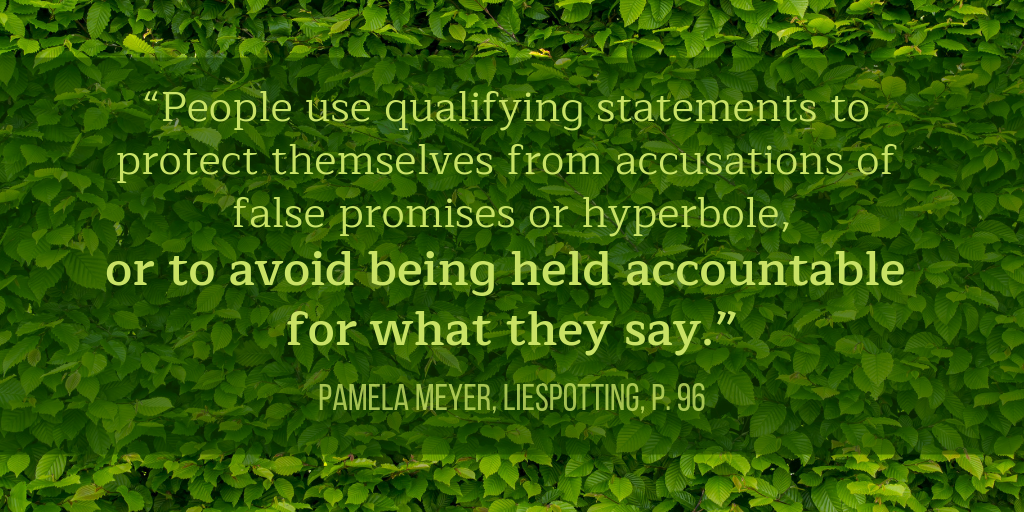 We complete the barrier object series with our final entry: hedges and qualifiers.
We complete the barrier object series with our final entry: hedges and qualifiers.
These rhetorical tidbits come in many forms. The terms “hedge” and “qualifier” are interchangeable. They denote words or phrases that damper the strength of a statement.
Hedges and Qualifiers
Grammatical hedges are literally named after a type of barrier. When we hedge, we use defensive language, something to retreat behind should anyone question our words. This is the rhetoric of the lawyer, the politician, the blogger, pretty much anyone in the service industry… and, well, everyone.
Everyone hedges to some degree or another. When you hedge too much, though, you look like a weasel.
Verbal Hedges
In this category we have “tempered” linking verbs and verb phrases. Consider the softening effect of the following:
- seem
- appear
- look
- tend to [verb]
- try to [verb]
- seem to have [verb]-ed
“He seemed angry” literally means there’s a possibility he wasn’t, but when you hear this spoken aloud, you assume the person in question was angry and the speaker is too polite to say it directly.
Similarly, “I tend to sleep in on weekends” comes from the mouth of someone who definitely sleeps in every weekend they possibly can but doesn’t want to sound like a lazy schmoe.
Politeness plays a huge role in hedging, as does conversational manipulation.
As a subcategory of verbal hedges, we have the conditional modals may, might, could, should, and would. If you compare them with their more solid modal counterparts, the hedge becomes glaring. For example,
- She might meet us at the restaurant.
- She must meet us at the restaurant.
Speaker #2 ain’t playing any games. Modal hedges shift from that concrete meaning to one with more wiggle room:
- must → may or might
- can → could
- shall → should
- will → would
And this simple shift makes a world of difference in responsibility to follow through.
As discussed in the article on Expanded Verb Structures, simpler structures are better. If you can eliminate a hedging modal for its concrete counterpart and still maintain the integrity of your narrative, good. But if you can eliminate the modal all together, better.
Adverbial and Adjectival Hedges
This type of hedge is a “fine tuner.” It emerges when a speaker wants to be meticulous about their language, again, to cover their backside from questions that a more direct discourse might elicit.
(Sidenote: yes, I’m using hedges to talk about hedges; like all barrier objects, they’re not always bad.)
Types
Adverbial and adjectival hedges gravitate toward certain semantic categories, including:
- Smallness: a bit, a little, slight(ly), at least
- Variety: kind of, sort of
- Frequency: often, sometimes, rarely
- Degree: rather, quite, somewhat
- Untruth: not very, not actually, not really, not certain, unsure
But here’s the thing: in most cases, these “specifications” add nothing more than word count. Someone who is “a little tired” is tired. If you’re “kind of annoyed,” you’re annoyed. When the hero makes a “slight grimace,” he grimaces. We don’t have to shy away from direct speech, particularly in expositional narrative.
Bolsters
As for the “untruth” category, its opposite falls under the linguistic pattern of bolstering, which is yet another tell for deception. We’ve all encountered a boor who interrupts a conversation with, “Well, actually…” and then proceeds to give their opinion rather than fact.
It’s a long-standing joke that anytime someone begins a statement with, “Honestly,” or its equivalent, they’re about to lie. This includes longer phrases like “in truth,” “in fact,” “in all candor,” “in all honesty,” and so forth. The instant we try to convince others of how genuine we are, we plant a seed of doubt.
If you’re shoring up your work with bolsters, they will have much the same effect as hedges.
They are both barriers.
Qualifying phrases
Hedge types expand into the rhetoric layer of language with phrases that temper responsibility. For example:
- As far as I know…
- To my understanding…
- From what I can see…
- By and large…
Each of these leaves more than enough room for a speaker to weasel out of their words. Unless you absolutely need them in your narrative, they are prime for culling.
When to Hedge
Hedges and qualifiers are 100% okay in spoken dialogue, as long as they suit the character. So too are they appropriate for narrative, but only if they add the nuance intended. In many cases, there are better alternatives to a hedge.
If, for example, your hero favors your heroine with a “slight smile” and the slightness of it plays into the scene, it’s appropriate. But a dozen other descriptors could convey the same effect or a better one.
- He favored her with a feeble smile.
- …a wry smile
- …an anemic smile
- …a guarded smile.
Or, if you’re going the analogy route,
- His smile was like a cup of weak tea.
All of these examples build on that more generic hedge of “slight.” But “slight” has its own charm, too, as long as it’s not modifying everything under the sun.
In Summary
Barrier objects create defensive writing, and defensive writing weakens your story. Our next section discusses a tool we can use to strengthen it instead.
***
Up next: The Cooperative Principle
Previous: Expanded Verb Structures
Back to Liar, Liar Navigation Page